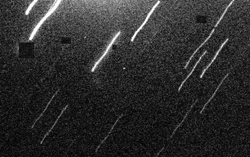EPOXI
Two intriguing investigations -- One flight-proven spacecraft
Earth Flyby 2007
Earth Flyby 2007
EPOXI's spacecraft has successfully completed the Earth flyby that will put the spacecraft on it's new trajectory. While the spacecraft took calibration frames in the infrared and visible wavelengths using the Moon, a few observers imaged the spacecraft as it flew past.
Read more...
closest approach occurred at: 31-DEC-2007 19:29:20.6633 UTC ± 0.0005 sec
height of EPOXI above Earth: 15567.626 ± 0.009 km
It's a plane! It's Superman! No, it's EPOXI's spacecraft heading towards Earth for a flyby on 31 Dec 2007!
After its encounter with Tempel 1 (green arc), the Deep Impact spacecraft, now being used for the EPOXI mission, continued in its orbit (yellow ellipse) around the sun that would bring it past Earth late this year. Along the way, there have been some trajectory correction maneuvers (TCMs) to adjust the spacecraft's path so that after the flyby it will be in an orbit (white circles) that will intersect with comet Hartley 2 (red arc) in 2010. During the flyby, the spacecraft will experience a gravity assist from Earth (blue circle) that will steal some of the orbital energy from the spacecraft, changing its orbit from the yellow path to the white one. Additional Earth flybys in 2008 and 2009 will refine the orbit even further.
Observing the Flyby

Direction of motion is from the right, counterclockwise through the loop with perigee ("P") occurring in NW Australia, roughly equidistant from the east and west ends of the loop. "C" marks the location of the Canberra DSN tracking station.
The spacecraft will be coming in from the nightside and going out on the dayside of Earth. The groundtrack (left) approximately shows where the spacecraft will be visible from Earth. But remember, the spacecraft is catching up to the Earth and then passing it. Therefore the best opportunities for viewing it will be in Australia and Southeast Asia between perigee and about an hour before perigee.
Where will EPOXI be in the sky? From 19-30 Dec, the spacecraft is located in the constellation Pisces and is visible in the evening sky. If you can see Pisces, then theoretically, you could see the spacecraft -- it is actually very faint, mag 20+. However, around 29 Dec, it will start to get close enough to be brighter than mag 20 and within several hours of perigee it could get as bright as mag 12 for observers who are closer to EPOXI as it approaches perigee. This should be observable in modest (8-10 inch aperture) and larger telescopes although other factors such as sky clarity, darkness, visual acuity also play a role.
To observe the spacecraft, three conditions must be met: (1) the sky must be dark, (2) the spacecraft has to be in sunlight (EPOXI satisfies this condition as it never goes into shadow behind the earth) and sunlight must be reflected toward the observer, and (3) the spacecraft has to be above the horizon. These three conditions are met when the "V" designator occurs at the left edge of the ephemeris listings. One of them is met when the "R" designator appears, namely, that the spacecraft is above the horizon ("V" denotes "visual"; "R" denotes "radio").
On Dec 31, when the spacecraft has its closest approach, your location in combination with the capability of your observing equipment will be critical in determining whether you will have an opportunity to see it or not. Early on the 31st (evening of the 30th Eastern Standard time), the viewing opportunity in the contiguous US will occur when EPOXI is still relatively far from perigee, and the spacecraft will be very faint. Following perigee, EPOXI will barely rise above the western horizon as seen from the west coast of the US. This happens in daylight so the spacecraft won't be observable without specialized equipment needed to detect faint astronomical objects in a daytime sky. In Hawai'i the spacecraft rises farther above the horizon than it does as seen from the US west coast, but again the pass is in daylight.
We have generated the ephemerides for a number of selected cities. These are text files (print landscape). A key for the columns is also given. Or for better accuracy, you can generate your own.
Submit Your Images
Even at closest approach, the spacecraft will be just over 15 thousand kilometers away! We expect that the spacecraft will be very faint, but brightening to about 12th magnitude within several hours of perigee. But we hope that folks will give it a try despite the many difficulties. And if you get an image, send it in!

 Southeastern Association for Research in Astronomy
Southeastern Association for Research in Astronomy Catalina Sky Survey
Catalina Sky Survey